Showing Spotlights 1833 - 1840 of 2781 in category All (newest first):
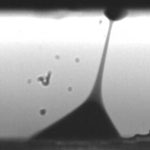 The ability to extract, dispense and manipulate very small amounts of liquids on the micro- and nanoscale is important in biotechnology, chemistry and also for patterning inorganic, organic and biological inks. Several methods for dispensing liquids exist, but many require complicated electrodes and high-voltage circuits. Researchers in Italy have now demonstrated a pyroelectrohydrodynamic droplet dispenser based on pyroelectric forces.Researchers in Italy have developed and demonstrated a completely new method for extracting and dispensing very small amounts of liquid - as small as few attoliters - from liquid droplet reservoirs or thin liquid films by a method called pyroelectrohydrodynamic (Pyro-EHD).
The ability to extract, dispense and manipulate very small amounts of liquids on the micro- and nanoscale is important in biotechnology, chemistry and also for patterning inorganic, organic and biological inks. Several methods for dispensing liquids exist, but many require complicated electrodes and high-voltage circuits. Researchers in Italy have now demonstrated a pyroelectrohydrodynamic droplet dispenser based on pyroelectric forces.Researchers in Italy have developed and demonstrated a completely new method for extracting and dispensing very small amounts of liquid - as small as few attoliters - from liquid droplet reservoirs or thin liquid films by a method called pyroelectrohydrodynamic (Pyro-EHD).
May 18th, 2010
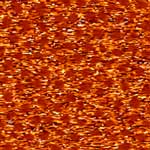 Ferroelectric materials have unique properties - spontaneous, switchable polarization, piezoelectricity, and pyroelectricity - that makes them attractive for a host of applications, ranging from medical ultrasound to examine fetuses and internal organs, military sonar for underwater navigation and detection, to energy harvesting devices for powering mobile gadgets. Recently, memory storage devices utilizing ferroelectrics have gained much attention due to their nonvolatility and fast switching speed. It was theoretically predicted that a nanodisk with a diameter of 3.2 nm could maintain spontaneous polarization. However the fabrication of ferroelectric nanostructure at this size level is extremely difficult and the smallest diameter for ferroelectric nanostructure with narrow size distribution obtained from experiments so far has been 60 nm. Researchers have now managed to prepare an ultrahigh density array of lead titanate nanoislands with a lateral dimension of 22 nm and a height of 7 nm.
Ferroelectric materials have unique properties - spontaneous, switchable polarization, piezoelectricity, and pyroelectricity - that makes them attractive for a host of applications, ranging from medical ultrasound to examine fetuses and internal organs, military sonar for underwater navigation and detection, to energy harvesting devices for powering mobile gadgets. Recently, memory storage devices utilizing ferroelectrics have gained much attention due to their nonvolatility and fast switching speed. It was theoretically predicted that a nanodisk with a diameter of 3.2 nm could maintain spontaneous polarization. However the fabrication of ferroelectric nanostructure at this size level is extremely difficult and the smallest diameter for ferroelectric nanostructure with narrow size distribution obtained from experiments so far has been 60 nm. Researchers have now managed to prepare an ultrahigh density array of lead titanate nanoislands with a lateral dimension of 22 nm and a height of 7 nm.
May 17th, 2010
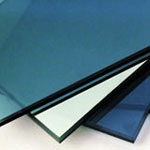 'Smart' windows, or smart glass, refers to glass technology that includes electrochromic devices, suspended particle devices, micro-blinds and liquid crystal devices. Their major feature is that they can control the amount of light passing through the glass and increase energy efficiency of the room by reducing costs for heating or air-conditioning. In the case of self-powered smart windows the glass even generates the energy needed to electrically switch its transparency. A new type of smart window proposed by researchers in The Netherlands makes use of a luminescent dye-doped liquid-crystal solution sandwiched in between electrically conductive plates as an energy-generating window.
'Smart' windows, or smart glass, refers to glass technology that includes electrochromic devices, suspended particle devices, micro-blinds and liquid crystal devices. Their major feature is that they can control the amount of light passing through the glass and increase energy efficiency of the room by reducing costs for heating or air-conditioning. In the case of self-powered smart windows the glass even generates the energy needed to electrically switch its transparency. A new type of smart window proposed by researchers in The Netherlands makes use of a luminescent dye-doped liquid-crystal solution sandwiched in between electrically conductive plates as an energy-generating window.
May 12th, 2010
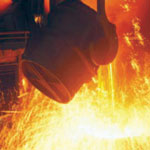 Steel is one of the most widely used engineering materials in the world. Its pre-eminent position amongst the engineering materials arises due to the abundance and low cost of its main constituent, i.e. iron, and its amenability to produce a wide variety of engineered microstructures with superior properties, and recyclability. Currently, there is a growing awareness about the potential benefits of nanotechnology in the modern engineering industry, and a number of leading research institutes and companies are pursuing research in the area of nanostructured steels. The focus of the ongoing efforts has been largely manipulation of microstructures at the nano-scale through innovative processing techniques and adoption of novel alloying strategies.
Steel is one of the most widely used engineering materials in the world. Its pre-eminent position amongst the engineering materials arises due to the abundance and low cost of its main constituent, i.e. iron, and its amenability to produce a wide variety of engineered microstructures with superior properties, and recyclability. Currently, there is a growing awareness about the potential benefits of nanotechnology in the modern engineering industry, and a number of leading research institutes and companies are pursuing research in the area of nanostructured steels. The focus of the ongoing efforts has been largely manipulation of microstructures at the nano-scale through innovative processing techniques and adoption of novel alloying strategies.
May 10th, 2010
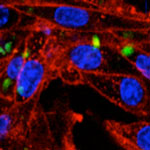 Cultured mammalian cells prefer growing on structured rather than on completely flat surfaces. In regenerative medicine, in which human cells must grow on artificial scaffolds to replace damaged tissue, appropriate biological signals, such as growth factors, but also mechanic stimuli should be provided at the nano and microscales for cell attachment and proliferation, mimicking the natural cell matrices in organic tissues. The straightforward fabrication of nanostructured surfaces as scaffolds for tissue engineering is complex, but instead, micro- and nanorugosities can be easily generated on flat surfaces by either top-down or bottom-up approaches. Researchers have demonstrated that bacterial inclusion bodies formed by biologically irrelevant polypeptides are convenient biomaterials for the bottom-up decoration of substrates for mammalian cell growth.
Cultured mammalian cells prefer growing on structured rather than on completely flat surfaces. In regenerative medicine, in which human cells must grow on artificial scaffolds to replace damaged tissue, appropriate biological signals, such as growth factors, but also mechanic stimuli should be provided at the nano and microscales for cell attachment and proliferation, mimicking the natural cell matrices in organic tissues. The straightforward fabrication of nanostructured surfaces as scaffolds for tissue engineering is complex, but instead, micro- and nanorugosities can be easily generated on flat surfaces by either top-down or bottom-up approaches. Researchers have demonstrated that bacterial inclusion bodies formed by biologically irrelevant polypeptides are convenient biomaterials for the bottom-up decoration of substrates for mammalian cell growth.
May 7th, 2010
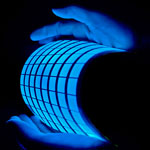 OLEDs - organic light-emitting diodes - are full of promise for a range of practical applications. OLED technology is based on the phenomenon that certain organic materials emit light when fed by an electric current and it is already used in small electronic device displays in mobile phones, MP3 players, digital cameras, and also some TV screens. With more efficient and cheaper OLED technologies it will possible to make ultra flat, very bright and power-saving OLED televisions, windows that could be used as light source at night, and large-scale organic solar cells. In contrast to regular LEDs, the emissive electroluminescent layer of an OLED consists of a thin-film of organic compounds. Exciton quenching and photon loss processes still limit OLED efficiency and brightness. Organic light-emitting transistors (OLETs) are alternative, planar light sources combining, in the same architecture, the switching mechanism of a thin-film transistor and an electroluminescent device. Thus, OLETs could open a new era in organic optoelectronics and serve as test beds to address general fundamental optoelectronic and photonic issues.
OLEDs - organic light-emitting diodes - are full of promise for a range of practical applications. OLED technology is based on the phenomenon that certain organic materials emit light when fed by an electric current and it is already used in small electronic device displays in mobile phones, MP3 players, digital cameras, and also some TV screens. With more efficient and cheaper OLED technologies it will possible to make ultra flat, very bright and power-saving OLED televisions, windows that could be used as light source at night, and large-scale organic solar cells. In contrast to regular LEDs, the emissive electroluminescent layer of an OLED consists of a thin-film of organic compounds. Exciton quenching and photon loss processes still limit OLED efficiency and brightness. Organic light-emitting transistors (OLETs) are alternative, planar light sources combining, in the same architecture, the switching mechanism of a thin-film transistor and an electroluminescent device. Thus, OLETs could open a new era in organic optoelectronics and serve as test beds to address general fundamental optoelectronic and photonic issues.
May 6th, 2010
 One of the greatest current environmental concerns both for the near term as well as for the future is global warming caused by man-made carbon emissions and its well-recognized impact on climate change. The various strategies which can be adopted to combat global warming are classified under the following three categories: 1) Reducing energy consumption by employing more efficient technologies that minimize use of fossil fuels; 2) Adopting technologies that utilize renewable energy and energy storage technologies; 3) Addressing carbon management issues that involve separation, capture, sequestration and conversion to useful products. The present article will specifically address the first two topics.
One of the greatest current environmental concerns both for the near term as well as for the future is global warming caused by man-made carbon emissions and its well-recognized impact on climate change. The various strategies which can be adopted to combat global warming are classified under the following three categories: 1) Reducing energy consumption by employing more efficient technologies that minimize use of fossil fuels; 2) Adopting technologies that utilize renewable energy and energy storage technologies; 3) Addressing carbon management issues that involve separation, capture, sequestration and conversion to useful products. The present article will specifically address the first two topics.
May 4th, 2010
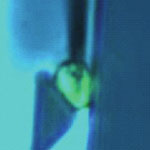 An intriguing novel approach to extract the energy from the photosynthetic conversion process has been demonstrated by researchers at Stanford and Yonsei Universities. They have inserted ultrasharp gold nanoelectrodes into living algae cells and extracted electrons, thereby harnessing an - albeit very tiny - electrical current. This is electricity production that doesn't release carbon into the atmosphere. The results demonstrate the feasibility of collecting high-energy electrons in steps of the photosynthetic electron transport chain and prior to the downstream processes associated with energy loss. In addition, the system allows direct monitoring of specific charge transfer reactions in live cells, leading to broad applications for investigating developmental processes and the responses of cells and organelles to light and chemical stimuli.
An intriguing novel approach to extract the energy from the photosynthetic conversion process has been demonstrated by researchers at Stanford and Yonsei Universities. They have inserted ultrasharp gold nanoelectrodes into living algae cells and extracted electrons, thereby harnessing an - albeit very tiny - electrical current. This is electricity production that doesn't release carbon into the atmosphere. The results demonstrate the feasibility of collecting high-energy electrons in steps of the photosynthetic electron transport chain and prior to the downstream processes associated with energy loss. In addition, the system allows direct monitoring of specific charge transfer reactions in live cells, leading to broad applications for investigating developmental processes and the responses of cells and organelles to light and chemical stimuli.
May 3rd, 2010
 The ability to extract, dispense and manipulate very small amounts of liquids on the micro- and nanoscale is important in biotechnology, chemistry and also for patterning inorganic, organic and biological inks. Several methods for dispensing liquids exist, but many require complicated electrodes and high-voltage circuits. Researchers in Italy have now demonstrated a pyroelectrohydrodynamic droplet dispenser based on pyroelectric forces.Researchers in Italy have developed and demonstrated a completely new method for extracting and dispensing very small amounts of liquid - as small as few attoliters - from liquid droplet reservoirs or thin liquid films by a method called pyroelectrohydrodynamic (Pyro-EHD).
The ability to extract, dispense and manipulate very small amounts of liquids on the micro- and nanoscale is important in biotechnology, chemistry and also for patterning inorganic, organic and biological inks. Several methods for dispensing liquids exist, but many require complicated electrodes and high-voltage circuits. Researchers in Italy have now demonstrated a pyroelectrohydrodynamic droplet dispenser based on pyroelectric forces.Researchers in Italy have developed and demonstrated a completely new method for extracting and dispensing very small amounts of liquid - as small as few attoliters - from liquid droplet reservoirs or thin liquid films by a method called pyroelectrohydrodynamic (Pyro-EHD).
 Subscribe to our Nanotechnology Spotlight feed
Subscribe to our Nanotechnology Spotlight feed





